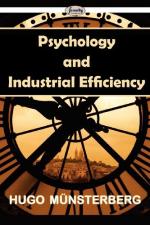Perhaps we know still less of the influences which coffee, tea, tobacco, sweets, and so on exert on the life of the industrial worker. It will be wise to resolve these stimuli in daily use into their elements and to study the effects of each element in isolated form. To know, for instance, the effects of caffein on the psychophysical activities does not mean to know the effects of tea or coffee, which contain a variety of other substances besides the caffein, substances which may be supposed to modify the effect of the caffein. Yet the first step must in this case be the study of the effects of the isolated caffein, before the total influences of the familiar beverages can be followed up. An excellent investigation of this caffein effect on various psychological and psychomotor functions has recently been completed.[48] When the caffein effect on tapping movements was studied, it was found that it works as a stimulation, sometimes preceded by a slight initial retardation. It persists from one to two hours after doses of from one to three grains and as long as four hours after doses of six grains. The steadiness test showed a slight nervousness after several hours after doses of from one to four grains. After six grains there is pronounced unsteadiness. A complex test in cooerdination indicated that the effect of small, amounts of caffein is a stimulation and that of large amounts a retardation. Correspondingly the speed of performance in typewriting is heightened by small doses of caffein and retarded by larger doses. In both cases the quality of the performance as measured by the number of errors is superior to the normal result.
The influences of the physiological stimulants have many points of contact with the effects of social entertainment, the significance of which for the economic life is still rather unknown in any exact detail. Many factories in which the labor is noiseless, as in the making of cigars, have introduced gramophone music or reading aloud, and it is easy to understand theoretically that a certain animating effect results, which stimulates the whole psychophysical activity But only the experiment would be able to decide how this stimulation is related, for instance, to the distraction of attention, which is necessarily involved, or how it influences various periods of the work and various types of work, how far it is true that the musical key exerts an exciting or relaxing influence, what intensity and what local position, what rhythm and what duration of such aesthetic stimuli, would bring the best possible economic results. We all have read of the favorable effects which were secured in a factory when a cat was brought into every working-room in which women laborers were engaged in especially fatiguing work. The cat became a living toy for the employees, which stimulated their social consciousness. In not a few plants the reinforced achievement is explained by the social means of entertainment, which




